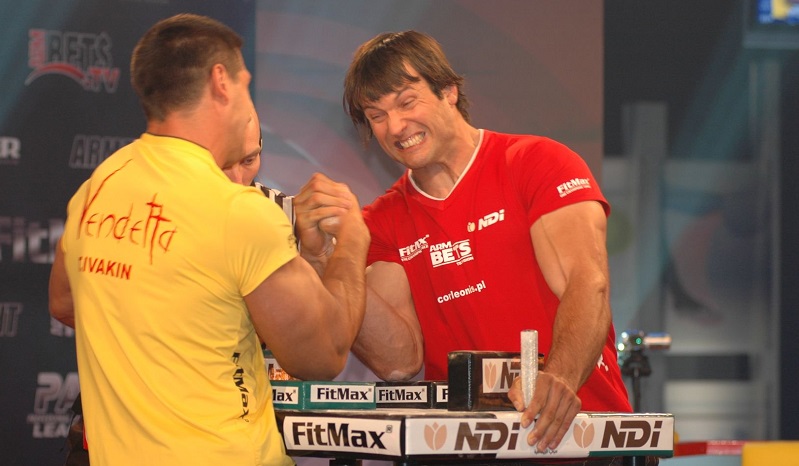Have you ever wondered why arm wrestlers can’t straighten their arms? It’s a curious phenomenon that has fascinated scientists and enthusiasts alike.
Arm wrestling, a sport that dates back centuries, involves two competitors using sheer strength to force the other’s arm to touch the pad. However, even after the match is over, arm wrestlers often find it challenging to fully straighten their arms.
Let’s delve into the fascinating reasons behind this seemingly bizarre occurrence.
Intense Training

First and foremost, arm wrestlers undergo intense training to build their arm muscles, especially the biceps and forearms. These muscles, responsible for powering through opponents, become exceptionally strong and well-developed. As a result, when an arm wrestler tries to straighten their arm, their bulging biceps can restrict the full extension of the joint. It’s almost like their powerful muscles act as a natural barrier, preventing complete straightening.
Tendons and Ligaments Problem

Additionally, arm wrestling puts an immense amount of pressure on the tendons and ligaments in the elbow joint. As competitors exert force in different directions, these soft tissues can become overstretched or even torn. The healing process involves scar tissue formation, which can limit the range of motion in the joint. Thus, arm wrestlers face a double whammy of muscular restrictions and scar tissue, making it challenging to fully extend their arms.
Biomechanics

Another factor contributing to arm wrestlers’ inability to straighten their arms lies in the biomechanics of the sport. When engaged in an arm wrestling match, competitors rely on a technique called pronation, which involves rotating the forearm outside in a top roll to generate force. This rotational movement puts additional strain on the elbow joint and further restricts the extension. It’s as if the joint and muscles have adapted to the repetitive motions of arm wrestling, molding themselves into a slightly curved position.
Proprioceptive Memory
Furthermore, arm wrestlers often encounter the psychological phenomenon known as proprioceptive memory. This memory refers to the body’s ability to remember positions and movements. After countless arm wrestling matches, an arm wrestler’s body becomes accustomed to the semi-extended state, considering it a default position. Consequently, even when they try to consciously straighten their arms, their muscles and joints resist, unintentionally reverting to the familiar position.
Constant Tension

Moreover, the nature of arm wrestling itself demands a tight grip and constant tension in the arm. During a match, maintaining a firm hold on the opponent’s hand is crucial for leverage and control. This persistent gripping can cause the muscles and tendons in the forearm to contract and tighten. The prolonged contraction further accentuates the challenge of straightening the arm.
The fascinating aspect of this phenomenon is that arm wrestlers’ inability to straighten their arms isn’t necessarily a negative consequence. Instead, it showcases the extraordinary strength and dedication these athletes possess. It serves as a testament to their hard work, determination, and sacrifices made in pursuit of victory. Arm wrestlers proudly bear this unique physical feature, wearing it as a badge of honor that separates them from the rest.
Impact on Joint Health

Expanding on the topic, let’s explore the impact of arm wrestling on joint health. While the restricted range of motion in the elbow may seem concerning, it’s important to note that arm wrestlers don’t experience any significant functional limitations in their daily lives. The specialized adaptations in their joints and muscles are specific to the sport. Outside of arm wrestling, they have full use of their arms and can carry out regular activities without hindrance.
When examining the long-term effects of arm wrestling, studies have shown that the sport doesn’t lead to chronic joint issues or arthritis. The exceptional strength and resilience of arm wrestlers’ muscles and connective tissues protect their joints from long-term damage. As long as proper training techniques and safety precautions are followed, arm wrestling can be enjoyed as a high-intensity sport without significant detrimental effects on joint health.
Furthermore, the physical demands of arm wrestling contribute to the overall fitness of the athletes. The explosive bursts of strength required in the sport build robust and powerful muscles, not only in the arms but also in the shoulders, back, and core. Arm wrestlers develop exceptional grip strength, which translates into improved performance in various other activities, such as weightlifting, rock climbing, and martial arts.
Considering the unique challenges faced by arm wrestlers, techniques to aid in straightening the arm have been developed. Stretching exercises, particularly those focusing on the biceps, triceps, and forearm muscles, can help improve flexibility and increase the range of motion in the elbow joint. Additionally, regular massage and manual therapy techniques can alleviate any tightness, allowing for greater extension of the arm.
Final Words
Arm wrestlers’ inability to straighten their arms stems from a combination of factors including powerful muscles, scar tissue formation, biomechanics, proprioceptive memory, and prolonged gripping. Rather than being a limitation, it showcases their dedication and physical prowess.
While arm wrestlers may face unique challenges in extending their arms, their joint health remains intact, and their exceptional strength and fitness levels are commendable. So, next time you see an arm wrestler with a slightly bent arm, remember the incredible strength and determination hiding behind that fascinating physical feature.

